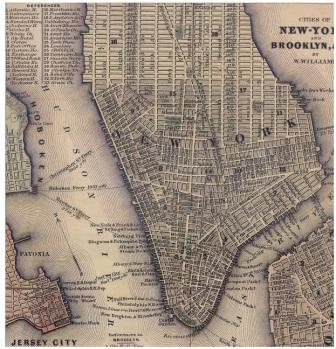 From newspaper and TV reports communicated some months ago, we learned that residents of housing estates around Ireland were concerned about horses that roam freely grazing on park land within these housing estates. Members of the “Travelling Community” , which had been newly housed in these estate have brought with them one of their customs, that of keeping a horse. The settled community feel these animals, wandering loose and unsupervised, are a danger to their children and elderly residents. It would appear that “the more things change the more they remain the same”, for similar fears were expressed by the inhabitants of New York city some 150 years ago regarding the custom of pig keeping.
From newspaper and TV reports communicated some months ago, we learned that residents of housing estates around Ireland were concerned about horses that roam freely grazing on park land within these housing estates. Members of the “Travelling Community” , which had been newly housed in these estate have brought with them one of their customs, that of keeping a horse. The settled community feel these animals, wandering loose and unsupervised, are a danger to their children and elderly residents. It would appear that “the more things change the more they remain the same”, for similar fears were expressed by the inhabitants of New York city some 150 years ago regarding the custom of pig keeping.
Half the total of Irish emigrants, many from Co. Tipperary, to all ports of the United States, before, during and after the Great Irish Famine, landed in New York city. Records show, that during a seven month period in 1847, a total of 52,946 Irish peasant immigrants landed in New York, from coffin ships.
New York was a rough, tough, and boisterous town, a centre of immense wealth, with fine buildings, but retaining some of the features of a frontier town. There was a strong feeling of `nativism` or America for the Americans in New York at this time .
The poem “The Colossus” by Emma Lazarus inscribed on the Statue of Liberty “Give me your tired, your poor, your huddled masses yearning to breathe free, the wretched refuse of your teeming shore,” etc., would have been, indeed, very much rejected in New York at this time. These starving, emaciated and spectre-like wretches, who tottered on shore in New York, also brought with them one of their customs, that of keeping a pig.
Vagrant pigs, acted as scavengers, wandering the streets at will. They consumed garbage, human slops, human and animal manure, and offal from butchers shops, converting it into flesh which could be eaten once again by humans. (Thurles Tidy Town people take note).
The Irish kept these animals in `hog pens` on any vacant lot that could be found, throughout the city. There were eight of these pig pens on 5th Avenue and 3rd Street alone and from there the occupants were turned out to forage for themselves. Novelist Charles Dickens (1812- 1870) in his travelogue “American Notes” referred to pigs as, quote, “Gentlemen hogs of Broadway”
On August 20th.1847 The Sun a New York newspaper (1833-1950) reports that no fewer than 10,000 pigs presently roam about the city, and are described ” as dangerous as hyenas“. On February 4th 1847 the New York Daily Tribune (1841-1924) talks about Irish pigs lounging up Broadway and Third Avenue.
The pig, by nature, is a rooting animal and has no sweat glands which means that they must have access to water or mud in which they can control their own body temperature. However, horses pulling laden carts, through the streets, with much needed supplies, occasionally fall breaking their legs in the holes and ruts made by the pigs, as they root in the rough muddy roadways. Attempts by the cities authorities to curb these pigs and capture them, were fiercely resisted by the Irish owners and were soon abandoned.
However, another nuisance in the New York of this time was to show the cities authorities a solution to the pig problem. This other nuisance was stray dogs. Mad dog attacks were common. The authorities in an effort to control these dogs, offered a reward of 50 cents for every dog clubbed to death. Indeed, “Municipal Dog Killers” were employed during the summer months to beat out the brains of any dog found without a muzzle on the streets. Between July 15th and August 25th 1847, a total of 1,510 dogs were clubbed to death. Other dogs found were clubbed to death by gangs of young boys anxious to earn the reward moneys offered. The New York Sun newspaper states that remaining dogs have learned the hours that the dog killers are about and conceal themselves, to later appear in droves.
The success of this dog killing project, now show the City Fathers that the offer of a reward is the solution for their pig problem and over the coming years all pigs begin to disappear off New York streets.

Leave a Reply